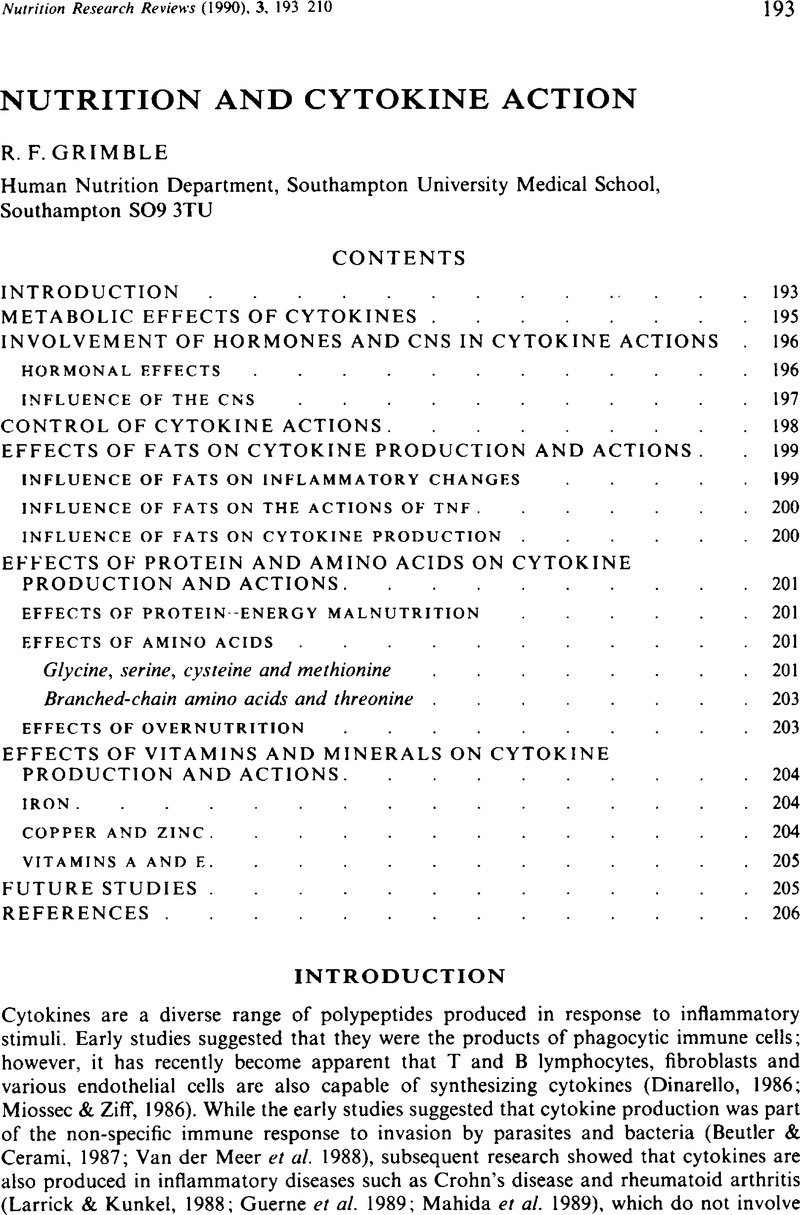Crossref Citations
This article has been cited by the following publications. This list is generated based on data provided by Crossref.
Dickerson, J. W. T.
1992.
Recovery from Brain Damage.
Vol. 325,
Issue. ,
p.
23.
Grimble, George K.
Payne-James, J. Jason
and
Silk, David B.A.
1992.
Advances in nutrition in the critically ill.
Baillière's Clinical Anaesthesiology,
Vol. 6,
Issue. 2,
p.
213.
Grimble, Robert F.
1992.
Dietary manipulation of the inflammatory response.
Proceedings of the Nutrition Society,
Vol. 51,
Issue. 2,
p.
285.
Pathirana, Chitra
and
Grimble, Robert F.
1992.
Taurine and Serine Supplementation Modulates the Metabolic Response to Tumor Necrosis Factor α in Rats Fed a Low Protein Diet.
The Journal of Nutrition,
Vol. 122,
Issue. 7,
p.
1369.
Grimble, R.F.
Jackson, A.A.
Persaud, C.
Wride, M.J.
Delers, F.
and
Engler, R.
1992.
Cysteine and Glycine Supplementation Modulate the Metabolic Response to Tumor Necrosis Factor α in Rats Fed a Low Protein Diet.
The Journal of Nutrition,
Vol. 122,
Issue. 11,
p.
2066.
Grimble, R.
1992.
Using cytokines..
BMJ,
Vol. 305,
Issue. 6854,
p.
649.
1992.
Abstracts of Communications.
Proceedings of the Nutrition Society,
Vol. 51,
Issue. 1,
p.
1A.
Thompson, R. L.
Margetts, B. M.
Wood, D. A.
and
Jackson, A. A.
1992.
Cigarette Smoking and Food and Nutrient Intakes in Relation to Coronary Heart Disease.
Nutrition Research Reviews,
Vol. 5,
Issue. 1,
p.
131.
Bashir, S.
and
Grimble, R. F.
1992.
Modulation of metabolic effects of TNFα by dietary fats.
International Journal of Food Sciences and Nutrition,
Vol. 43,
Issue. 2,
p.
105.
Hume, M. C.
1992.
Self help organization's advice on myalgic encephalomyelitis..
BMJ,
Vol. 305,
Issue. 6854,
p.
649.
Williams, A. F.
1992.
Human milk banks..
BMJ,
Vol. 305,
Issue. 6854,
p.
648.
Grimble, Bob
1993.
My favourite paper.
Nutrition Bulletin,
Vol. 18,
Issue. 3,
p.
192.
Grimble, R. F.
1993.
Yearbook of Intensive Care and Emergency Medicine 1993.
p.
212.
Singhal, A.
Thomas, P.W.
Serjeant, B.E.
Serjeant, G.R.
Doherty, J.F.
Raynes, J.G.
and
McAdam, K.P.W.J.
1993.
Is there an acute-phase response in steady-state sickle cell disease?.
The Lancet,
Vol. 341,
Issue. 8846,
p.
651.
Grimble, Robert F.
1994.
2. Impact of nutrients on cytokine biology in infection.
Transactions of the Royal Society of Tropical Medicine and Hygiene,
Vol. 88,
Issue. 6,
p.
615.
Dickerson, J.W.T.
and
Morgan, Jane B.
1994.
Scientific Foundations of Biochemistry in Clinical Practice.
p.
218.
Crabtree, J E
Wyatt, J I
Trejdosiewicz, L K
Peichl, P
Nichols, P H
Ramsay, N
Primrose, J N
and
Lindley, I J
1994.
Interleukin-8 expression in Helicobacter pylori infected, normal, and neoplastic gastroduodenal mucosa..
Journal of Clinical Pathology,
Vol. 47,
Issue. 1,
p.
61.
Johnson, N.W.
and
Curtis, M.A.
1994.
Preventive Therapy for Periodontal Diseases.
Advances in Dental Research,
Vol. 8,
Issue. 2,
p.
337.
Enwonwu, C.O.
1994.
Cellular and molecular effects of malnutrition and their relevance to periodontal diseases.
Journal of Clinical Periodontology,
Vol. 21,
Issue. 10,
p.
643.
Durán-Chávez, Carolina
Sánchez-Herrera, Gabriela
Cañedo-Solares, Irma
and
Pérez-Ortíz, Bartolomé
1994.
C-Reactive protein in severely malnourished children.
Nutrition Research,
Vol. 14,
Issue. 7,
p.
967.





